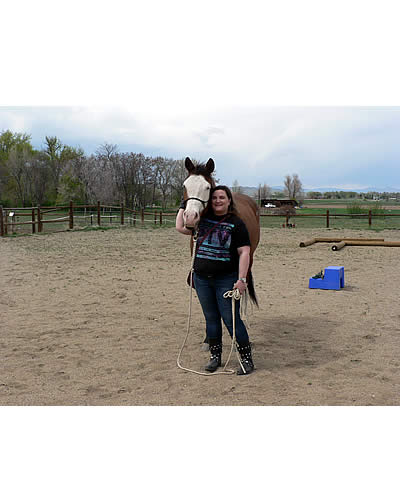By: Jessica Levin
It was a beautiful day outside; the first blush of spring was finally on the horizon with the beautiful Rocky Mountains framing a breathtaking picture. All week, as I pondered my life-changing trip, the temperature in Denver had hovered around 30, but today was different — it was 50 degrees. When I got out of my car, I inhaled the crisp, clean winter air. I couldn’t contain my excitement; it was coursing through my veins. Then I saw a beautiful horse. She is not your “run of the mill” horse; she is not just any horse; she is Penelope!
Penelope is a beautiful and unusual horse. She lives every day with Hereditary Equine Regional Dermal Asthenia (HERDA). HERDA is an inherited collagen deficiency. Researchers have confirmed abnormal skin, tendons, ligaments, heart valves and eyes. Due to persistent wounds, most horses with this genetic disease cannot be ridden or shown competitively and are humanely euthanized.
There’s a similar disease in humans called Ehlers-Danlos Syndrome (EDS). EDS is an inherited connective tissue disorder which affects multiple systems in the body and is caused by a defect in collagen. Collagen is essential as it helps keep bones, joints, muscles, ligaments, blood vessels and organs strong, stable and secure. However, the collagen in people with EDS is more elastic than it should be, which can cause pain, joint dislocation, organ problems, skin ailments and more.
If you were to look at me, you’d never know all the things I struggle with daily. None of it is visible. In fact, I have a couple invisible illnesses which I have endured virtually my entire life, one of which is Ehlers-Danlos Syndrome. Most people look at me and think: “What could possibly be wrong with her?” or “She must be a hypochondriac!” These comments are not only frustrating and hurtful, but they are also things I hear much too often. Even so, I consider myself lucky because I’m not in a wheelchair and I don’t have to walk with a cane. Some other people with EDS have to rely on these assistive devices. However, the excruciating pain I experience can still be debilitating.

Robin pointed out Penelope’s damaged skin. She had scars where a saddle had rubbed her too hard, a long scar on her face from an accident, and a few others from trying to live like a normal horse. One might think: “What’s the big deal about a few scars?” The difference is that Penelope’s skin tears easily and scars worse than other horses. Normally, a horse can wear a saddle and be ridden with little to no complications. This isn’t possible for Penelope because her skin is too fragile. I was so interested in this because I have skin issues caused by EDS. Five years ago, I had laparoscopic surgery, which typically leaves four half-inch scars on the torso. However, I developed huge puffy, painful scars called keloids – another lovely side effect of my EDS. Just then, I started to realize how similar I was to Penelope.
I got to see Penelope’s playful side as well. I couldn’t contain my joy and laughter when I saw Penelope lower herself to the ground, flip onto her back and then roll around in the snow. It was quite possibly the cutest thing I’d ever seen, especially when done by such a large animal. It also reminded me that I still find joy in many different aspects of my life despite all the pain I live with daily.
Abnormal flexibility is a bad thing, because it leads to joint pain. Penelope showed us some of her unusual range of motion by taking treats from different positions. Seeing an animal with unnatural flexibility was fascinating. But then I was struck with a deeper realization: there was another being on this earth that was so very similar to me. I felt like I could understand Penelope’s daily struggles. For example, my joints are so flexible that I can press my thumb flat against my wrist. In addition, my knees have always hyperextended, despite attempts to correct it with physical therapy.
I think the best part of the day was when Robin gave us carrots to feed to her. I loved how her furry lips brushed my hand as she gently ate the carrot that I held in my palm.
Seeing as Penelope is non-verbal, she is very fortunate to have someone like Robin in her life. When Penelope is groomed, it is of the utmost importance to inspect her body from head to tail rather than focus on making her pretty. She also must be watched for any change in behavior, such as lameness, which is caused by more elastic tendons/ligaments that have given Penelope premature arthritis. I feel that I am equally lucky as my family is very supportive and has advocated for me on numerous occasions. Something that most people with EDS find frustrating is how long it takes to get diagnosed. I have been to more doctors than I can count and only two of them actually had an understanding of Ehlers-Danlos Syndrome. The best way to help individuals who struggle with EDS is by raising awareness, in the medical community and in the public at large.
I will never forget my day with Penelope. She not only showed me that I am not alone with this struggle, but that it is still possible to lead a productive and satisfying life. She gave me hope and inspiration.
For more information on HERDA: www.herdahorse.com.
For more information on EDS: www.ednf.org.
